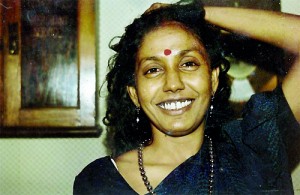
Sunday, 21st September 2014
By Namini Wijedasa

Remembering a Jaffna academic, who is still an inspiration to all who fight for human rights, twenty-five years after she was gunned down by the LTTE
It was near 7 pm and the light was fading. Most residents of Jaffna knew better than to loiter in the streets. But one lone man who rode into Rajan Hoole’s front yard on his bicycle had lost too much to care.
“Rajan, do you know that Rajani was shot?” he asked. Twenty-five years later, the memory of that moment is still indelibly stamped in their minds.
Rajani had the courage to stand up for anything she felt was correct
The man on the bicycle was Alvappillai Rajasingham. Less than two hours earlier, at 5.30 pm, the Liberation Tigers of Tamil Eelam (LTTE) had gunned down his daughter-a Jaffna academic called Rajani Thiranagama. She was 35-years-old and a mother of two young children. It was September 21, 1989.
Rajani, a trained medical doctor and lecturer, was a founding member of the University Teachers for Human Rights (Jaffna). Among its objectives was to document human rights violations by all sides – be it the LTTE, the Indian Peacekeeping Forces or the Sri Lankan military. Their first reports emerged from the University of Jaffna in 1988.
According to the UTHR (J)’s own literature, the Tigers were at war with “all alternative voices in the Tamil community”. Despite this, four academics of the university co-authored a book called the ‘The Broken Palmyra’ chronicling human rights abuses and exposing all perpetrators, including the LTTE.
Rajani was one author, as was Rajan. The others were Daya Somasundaram and Kopalasingham Sritharan. The final edit was published in 1990 but the pre-publication version had been in circulation months ahead. It was one of the things Rajani paid for with her life.
Her friends and family were deeply affected by Rajani’s death. The UTHR (J) was badly hit. “Half of the staff of the Jaffna University signed on to the original UTHR (J),” recalls Rajan today. “That was more than 100. Once Rajani was killed, the number dwindled. We then had about five to 10 active sympathisers.”
But Rajan and Sritharan carried forward the ideals of the organisation. Even under threat, they compiled bulky reports on the conflict and spared no one. They used an impeccable network of sources to document massacres and ground attacks, air raids and naval assaults, suicide bombs and explosions, ground operations and torture, assassinations and abductions, rape and sexual assault, military excesses and so on.
The last report came out after the end of the war in 2009, twenty years after Rajani’s death. Today is her 25th death anniversary. “Rajani foresaw what would happen to the LTTE,” Rajan said. “She understood the social forces. I don’t think anything would have surprised her in the way it ended.”
One of the reasons Rajan continued his activism was the manner in which Rajani died. “When we wrote ‘The Broken Palmyra’, we decided we will publish the book at whatever the cost,” he said. “Once Rajani was killed, the extent of betrayal would have been greater if we dropped out. We had to bring out the sides of the story that others were not bringing out.”
Those who loved the activists urged them to flee. “When the funeral was over, the fear and the emptiness grew,” remembers Kirupa, Rajan’s wife. “Everyone pestered us, saying it is better for us to leave. But Rajan and Sri were adamant that it was wrong to go after what happened to their colleague.”
“Rajan told me that he would never be able to run away from this place and live with a clean conscience,” she said. “He didn’t want to forget about everything and carry on with his life. He wanted to continue the work they believed in.”
Rajani had the courage to stand up for anything she felt was correct, Kirupa observed: “She had a vision. She understood the grassroots and the militants. She saw how children had left everything, their youth, education and families, and how they could not return to normal life.”
“She saw where this struggle would lead them,” she concluded. “She believed we had to question and correct ourselves, rather than blame others.”
There weren’t many that listened. But one of Rajani’s greatest legacies is that she inspired at least a handful of people to never, ever stop trying.
From : http://www.sundaytimes.lk/140921/sunday-times-2/rajani-right-is-might-118886.html




